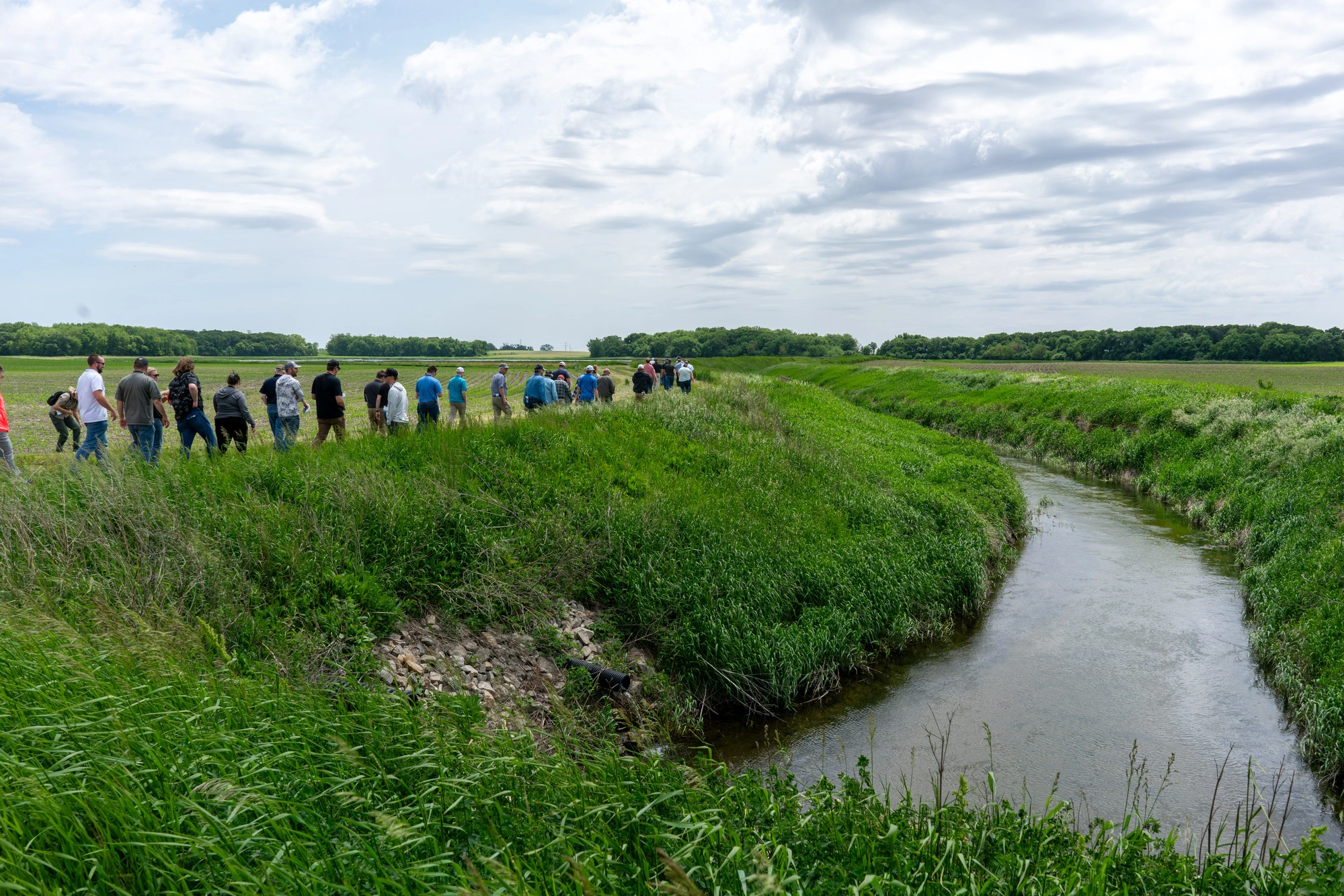A Cyclical Approach to Lake Management
There’s no one-size-fits-all when it comes to lake water quality management. The unique characteristics of a lake and its surrounding watershed, require development of a custom plan to improve lake health. With so many variables impacting each lake, it can be difficult to understand what the problem is, optimal solutions, and equally important, how to pay for them.
ISG’s water resource engineers and environmental scientists use a four-step adaptive lake management process to assess problems, plan solutions, implement priorities, and monitor results in a cyclical, flexible approach. To help understand the time and resources needed to achieve a lake management plan, the four steps of adaptive lake management are explained in greater detail below.
- ASSESS: Understand Existing Conditions
Determining what is impacting lake water quality is the first step in the process. A thorough understanding of impacts is needed before addressing potential solutions. An assessment of existing conditions examines the characteristics of the watershed and lake and how they interact; helping lake stakeholders understand the issues facing their lake. The team begins by reviewing existing monitoring data, both qualitative and quantitative. Documents such as the Minnesota Pollution Control Agency’s Watershed Restoration and Protection Strategy (WRAPS) and comprehensive watershed management plans are reviewed to understand existing conditions. Previously generated Total Maximum Daily Load (TMDL) models are often refined to define the lake more accurately and allow the team to assess potential results of certain watershed and in-lake treatment improvements to determine how the lake will respond.
Once the assessment is completed, the team can identify the lake’s internal loading (the breakdown of vegetation and other organic matter and release of dissolved phosphorus in the water) and external loading (runoff from the watershed into the lake), which steers the course of action. This detailed analysis helps the team understand how to prioritize resources and funding to make the biggest improvement to lake health.
- PLAN: Multi-benefit Solutions
A successful lake management plan requires clear goals and objectives that can be monitored over time to determine if the solutions are working to impact the identified issue(s). ISG engineers and scientists use the assessment data to help lake stakeholders understand the scale of effort needed and where to focus those efforts to see the biggest return on their investment. For example, if it’s determined that efforts should focus within the watershed, ISG uses science-backed information to determine the ideal location and size of a wetland, storage pond, or other nutrient reduction practices needed to reduce lake pollutants. If the reduction of internal loading will have the greatest benefit, ISG recommends in-lake treatment options as a priority, which in most cases requires budgeting for implementation and monitoring to further refine treatment tactics. Ideally, multiple water quality practices are linked together to achieve the greatest benefit to the watershed and lake.
- IMPLEMENT: Best Management Practices
A lake management plan can be leveraged to apply for local, state, and federal grants. Successful planning efforts maximize funding and partnership opportunities, often with the help of grant writing professionals who have a clear picture of available funding opportunities. To bring value and help communities implement plan solutions, ISG proactively researches funding and partnership sources for clients. ISG recognizes that integrating grant writing into the planning process can make the most of matching dollars, grants, and other funding programs.
Our water resources team has trusted relationships with agencies such as the Minnesota Board of Water and Soil Resources (BWSR) that award grants in Minnesota. These connections allow our funding team to quickly obtain answers to questions and develop grant applications that adhere to each agency’s criteria and processes, increasing the likelihood that they will be awarded. Since 2015, ISG’s grant writing team has helped secure over $34 million in grants while leveraging over $21 million in public and private dollars for projects across the Midwest. Once funding is obtained, lake managers can move forward with implementing watershed and in-lake practices.
- MONITOR: Treatment Strategies
ISG’s water resources teams perform internal and external load monitoring to determine how the treatment solutions are working or to further identify target areas for implementation. For example, the team monitors restored wetlands to ensure that the wetlands are reducing phosphorus loading and performs internal lake monitoring to see how dissolved oxygen, temperature, and phosphorus profiles are recovering after the treatment. After the monitoring data is collected, the team returns to the initial assessment to determine if goals have been met or if more assessment or monitoring is needed. In cases where internal loading is the driving factor of pollution, recurring monitoring within the lake can track trends in water quality data to determine what the internal loading source may be (such as sediment phosphorus release) and specific source treatment areas.
A Flexible, Cyclical Approach
Adaptive lake management asks that lake managers be open to the process of defining the problem with their lake so that the team can develop the best solutions. Lake managers often are focused on one problem or assume that it is being caused by a certain watershed practice. It’s important to remember that each lake has its own unique characteristics, making the assessment phase key in defining the problem and refining a solution. At the end of the monitoring phase, existing lake conditions are often reassessed, remodeled, or recalibrated to understand how to refine the plan going forward. The lake management cycle starts over—with more data and insight—moving lake managers closer toward achieving long-term water quality goals.
ISG’s water resources team understands the vital role that lakes play in supporting communities both recreationally and economically. On April 22, 2023, ISG will host the inaugural Future of Southern Minnesota Lakes Conference, designed to equip lake managers on the adaptive lake management process, lake restoration, and the resources available to improve lake health. With over 50 years of experience in water resources management, ISG is working at the forefront of water quality practices to assist landowners, communities, and lake associations to serve as vital stewards of these important resources.


Related Articles

.webp)
ISG Recognized as a 2025–26 Emerging Professional Friendly Firm for the Fourth Consecutive Cycle
ISG has been honored as a 2025–26 Emerging Professional Friendly Firm by AIA chapters in North Dakota, South Dakota, Wisconsin, and Minnesota in recognition of its commitment to fair compensation, licensure support, mentorship, and growth for early-career architects.













